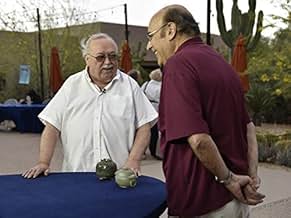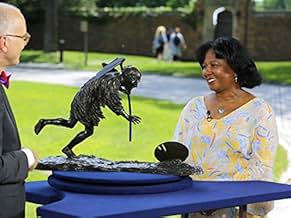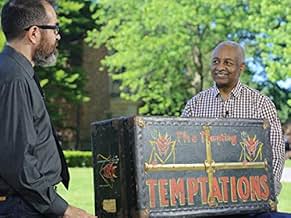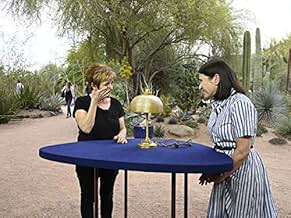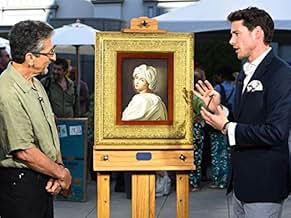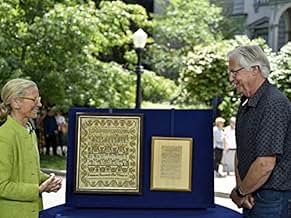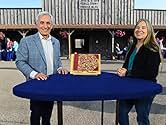NOTE IMDb
7,3/10
1,4 k
MA NOTE
Ajouter une intrigue dans votre langueCollectors discover that they can turn trash into treasure, thanks to the appraisal skills of the show's specialists in antiques and fine art; Mark L. Walberg hosts.Collectors discover that they can turn trash into treasure, thanks to the appraisal skills of the show's specialists in antiques and fine art; Mark L. Walberg hosts.Collectors discover that they can turn trash into treasure, thanks to the appraisal skills of the show's specialists in antiques and fine art; Mark L. Walberg hosts.
- Nommé pour 21 Primetime Emmys
- 1 victoire et 25 nominations au total
Parcourir les épisodes
Avis à la une
Don't waste your time unless you are sure you have something very valuable, and then don't be so sure. We brought antiques to be appraised and felt snookered into waiting much longer than we were led to believe we would have to wait. You are given a time to enter and are led to a very long line. That line took about 2 hours. Toward the end of the line I asked how much longer we'd have to wait and was told "five minutes." Thinking we had finally got to where we would have our objects appraised, we were led to another two-hour line. If you wanted two items of different types appraised, you had to join yet another two-hour line for the second item. At the end of our 4-hour wait, we were told that our object was worth very little. We learned that an object may be 100 years old, but if it wasn't worth much to begin with, it still isn't. I could have taken it in to an appraiser, paid a little money, and found that out without the four-hour wait, not to mention the time spent to get to and from the venue where the event was held. Most people had their objects packed so you see very little of what other people are bringing, so there really is not much fun in it. Save yourself the trouble.
Let's face it, we are all trying to make money in these tough times or invest it in antiques. In this series, the appraisers travel around the country to appraise various items. There are always interesting items that pop up at the road shows. There are thousands of willing guests praying that they hold a treasure among their prized possessions. One guy brought Gale Sayers football jersey with marks and all that his wife was going to throw out. The appraiser valued it at 20,000-30,000 easily. The jersey was priceless anyway because of the history during his season. Of course, some people like myself look around for my most valuable piece whether it's furniture or a book. One lady retrieved a book from the garbage which was an actual screenplay to an early film with autographs from the director, writer, and major cast members. She saved it from near destruction. Now, not everything is going to be valuable unless you pay a lot of money or go treasure hunting. I think this hobby is better suited for adults. Check around to see if you have a valuable painting etc. that could pay the bills or if not. Keep looking, and watch and learn from the show itself.
Roadshow, while it does nothing to compensate the original artisans who created these works (they presumably were compensated at original manufacture?), does help the rest of us who might discover a potential windfall in our attic. The show's long run has actually HURT the rich antique collectors in the sense that hundreds of thousands of everyday people now know what these pieces are worth, and they are not as easily duped by the proliferation of unscrupulous dealers.
To say that we should completely forsake collectibles in favor of buying new goods is to say that we should never place a premium on quality and craftsmanship, for that is the common thread. We should be happy with a few new music discs or movies, rather than have a large collection of great and classic material purchased used.
There is room for both, and this is another example of where we need balance in our lives. Besides, it is great entertainment!
To say that we should completely forsake collectibles in favor of buying new goods is to say that we should never place a premium on quality and craftsmanship, for that is the common thread. We should be happy with a few new music discs or movies, rather than have a large collection of great and classic material purchased used.
There is room for both, and this is another example of where we need balance in our lives. Besides, it is great entertainment!
I love the American version of "Antiques Roadshow" that is shown on PBS. It's very, very interesting and even my daughter loved it when she was a tiny kid. Why? Because the stories are so interesting and the appraisals so enlightening. Think about it--folks bring in their knickknacks and treasures to discover if they are actually worth something--and that's most of what the show is all about other than a visit in each episode to a museum or collection for a short interlude in the middle of the show.
Although the British first came up with "Antiques Roadshow", I find that I prefer the American one (though I watch both). That's because, for me, much of the excitement of the show is watching the reactions on the public when they get their appraisals--and the British reactions are, in general, much more muted.
Although the British first came up with "Antiques Roadshow", I find that I prefer the American one (though I watch both). That's because, for me, much of the excitement of the show is watching the reactions on the public when they get their appraisals--and the British reactions are, in general, much more muted.
This show is actually derived from a British show of the same name produced by the BBC that began in 1979. The name "Antiques Roadshow" (the American PBS version) is somewhat of a misnomer as an antique is generally defined as an artifact dating before 1900. The showcased artifacts come under the larger umbrella term "collectibles". A collectible is essentially any item that has some kind of premium value above and beyond what it either originally sold for and/or an item of exceptional quality and/or rarity. Often that can mean an older item but not always.
For example, there are hundred-year old items, such as Bibles from the late 1800's that are worth only $10 to 20 (low demand versus high quantity) while there are lamps and chairs by influential designers from the 1960's that are worth $10,000's. Ancient coins 1500+ years old are actually quite numerous (millions of them exist) and many can be obtained for only a few dollars. Simultaneously, a Tiffani lamp from about 100 years ago can fetch from $50,000 to $150,000. The age of the item does not necessarily predict its worth, although the older an item, the more likely less of them still exist. An item's market value depends upon what it is, its condition, how many of them survive, and what kind of demand there is with the last factor being the most determining. Items of scarcity with little or no demand still can't compete with items of more numerous quantity in which the demand is very high.
One of the criticisms of this show is that some of the appraisals seem high, and a few up in the stratosphere. Viewers should keep in mind that these appraisals are only estimates, and the appraisers are advertising themselves and their services. Collectible items have a way of fluctuating up-and-down depending upon current market trends. As of this writing in Fall of 2009, many collectibles have dipped in value (some by as much as 40%) as a result of the current economic instability. An item is only worth what someone is willing to pay for it despite popular misconception that artifacts have intrinsic worth except in regards to heirlooms and personal items that are priceless to a particular family or group. Just because an artifact or premium item sold for such-and-such an amount in the past does not mean they will necessarily realize it in the future, but that information can be used to approximate a current value. And there are a few items whose collectible values have receded over the years because demand has lessened; this appears to be the exception and not the rule. And of course, there is always the problem of fakes and facsimiles, and the experts have many ways to tell the difference.
The dealer-appraisers on the show are constantly looking for new clients who have premium items to sell and/or consign on the collectibles-antiques market. When these appraisers and dealers say "auction", they are usually referring to the very well-publicized high-end international auctions, such as Christies and Sothebys. There are numerous smaller auctions around the United States, and not all of them can fetch the kind of money realized by the international houses. Also, a few of these people are high-end dealers who own a shop and/or company, some of whose clients are household names, like financial magnate Donald Trump and football celebrity Joe Montana who collect Ancient Roman and Greek artifacts from antiquity. So while an item might realize $100,000 at a Sotheby's auction, a smaller auction in a smaller community may only be able to realize a fraction thereof.
After having watched the show religiously for going on 5 years, I gather that many of the people who bring their items to the show are unaware of the vastness of the collectibles-antiques market and how much money it makes every year. A few participants are flabbergasted when the painting they were going to throw away is appraised at between $50,000 to $100,000. Most of the participants have modest incomes, and couldn't imagine paying the kind of money that some of these items are worth. Some of the best moments are the appraisals of items that were found at yard sales and thrift shops for under $100 (sometimes under $20) that turn out to be worth a small fortune. On the other side of the spectrum, there are the fakes and facsimiles, some of which are almost indistinguishable from authentic pieces. There have been a handful of participants who have been duped into paying good money for an item that, after close scrutiny by the expert, lacks authenticity, some of which were specifically designed to deceive well-intentioned buyers. Buyer beware!
Without having been to the Roadshow, I would venture that 90% of the items brought have little value, under $100 in other words. Of that 10%, probably 90% of those are in the $100 to $1000 range. And then there is the cream of the crop, items that have serious value, which probably represents less than 1% of all the items brought to the show. It is these items that are showcased on the television broadcast, although my understanding is that having one of these items does not guarantee a spot.
The main point of the show, I think, is that there are many collectible items that are still out there. You don't have to go to Christie's and Sotheby's to find some of these things if you are of more modest means. Certainly, you are probably not going to find a Rembrandt or a Da Vinci at a Salvation Army Thrist Store, but you might find something that is worth much more than the asking price. And don't pay good money for items unless the dealer's reputation is well documented. Do not collect for value alone which could be disappointing in years to come. The golden rule of collecting is to collect what you enjoy.
For example, there are hundred-year old items, such as Bibles from the late 1800's that are worth only $10 to 20 (low demand versus high quantity) while there are lamps and chairs by influential designers from the 1960's that are worth $10,000's. Ancient coins 1500+ years old are actually quite numerous (millions of them exist) and many can be obtained for only a few dollars. Simultaneously, a Tiffani lamp from about 100 years ago can fetch from $50,000 to $150,000. The age of the item does not necessarily predict its worth, although the older an item, the more likely less of them still exist. An item's market value depends upon what it is, its condition, how many of them survive, and what kind of demand there is with the last factor being the most determining. Items of scarcity with little or no demand still can't compete with items of more numerous quantity in which the demand is very high.
One of the criticisms of this show is that some of the appraisals seem high, and a few up in the stratosphere. Viewers should keep in mind that these appraisals are only estimates, and the appraisers are advertising themselves and their services. Collectible items have a way of fluctuating up-and-down depending upon current market trends. As of this writing in Fall of 2009, many collectibles have dipped in value (some by as much as 40%) as a result of the current economic instability. An item is only worth what someone is willing to pay for it despite popular misconception that artifacts have intrinsic worth except in regards to heirlooms and personal items that are priceless to a particular family or group. Just because an artifact or premium item sold for such-and-such an amount in the past does not mean they will necessarily realize it in the future, but that information can be used to approximate a current value. And there are a few items whose collectible values have receded over the years because demand has lessened; this appears to be the exception and not the rule. And of course, there is always the problem of fakes and facsimiles, and the experts have many ways to tell the difference.
The dealer-appraisers on the show are constantly looking for new clients who have premium items to sell and/or consign on the collectibles-antiques market. When these appraisers and dealers say "auction", they are usually referring to the very well-publicized high-end international auctions, such as Christies and Sothebys. There are numerous smaller auctions around the United States, and not all of them can fetch the kind of money realized by the international houses. Also, a few of these people are high-end dealers who own a shop and/or company, some of whose clients are household names, like financial magnate Donald Trump and football celebrity Joe Montana who collect Ancient Roman and Greek artifacts from antiquity. So while an item might realize $100,000 at a Sotheby's auction, a smaller auction in a smaller community may only be able to realize a fraction thereof.
After having watched the show religiously for going on 5 years, I gather that many of the people who bring their items to the show are unaware of the vastness of the collectibles-antiques market and how much money it makes every year. A few participants are flabbergasted when the painting they were going to throw away is appraised at between $50,000 to $100,000. Most of the participants have modest incomes, and couldn't imagine paying the kind of money that some of these items are worth. Some of the best moments are the appraisals of items that were found at yard sales and thrift shops for under $100 (sometimes under $20) that turn out to be worth a small fortune. On the other side of the spectrum, there are the fakes and facsimiles, some of which are almost indistinguishable from authentic pieces. There have been a handful of participants who have been duped into paying good money for an item that, after close scrutiny by the expert, lacks authenticity, some of which were specifically designed to deceive well-intentioned buyers. Buyer beware!
Without having been to the Roadshow, I would venture that 90% of the items brought have little value, under $100 in other words. Of that 10%, probably 90% of those are in the $100 to $1000 range. And then there is the cream of the crop, items that have serious value, which probably represents less than 1% of all the items brought to the show. It is these items that are showcased on the television broadcast, although my understanding is that having one of these items does not guarantee a spot.
The main point of the show, I think, is that there are many collectible items that are still out there. You don't have to go to Christie's and Sotheby's to find some of these things if you are of more modest means. Certainly, you are probably not going to find a Rembrandt or a Da Vinci at a Salvation Army Thrist Store, but you might find something that is worth much more than the asking price. And don't pay good money for items unless the dealer's reputation is well documented. Do not collect for value alone which could be disappointing in years to come. The golden rule of collecting is to collect what you enjoy.
Le saviez-vous
- AnecdotesThe most valuable item ever appraised at a Roadshow event (unaired) was a collection of autographs from every Presidential cabinet member from George Washington to Franklin Roosevelt, valued at a million dollars. Not surprisingly, the owner did not wish to appear on the show.
- ConnexionsFeatured in Un mariage trop parfait (2001)
Meilleurs choix
Connectez-vous pour évaluer et suivre la liste de favoris afin de recevoir des recommandations personnalisées
- How many seasons does Antiques Roadshow US have?Alimenté par Alexa
Détails
- Date de sortie
- Pays d’origine
- Sites officiels
- Langue
- Aussi connu sous le nom de
- Antiques Roadshow US
- Lieux de tournage
- Société de production
- Voir plus de crédits d'entreprise sur IMDbPro
- Couleur
- Rapport de forme
- 16:9 HD
- 4:3
Contribuer à cette page
Suggérer une modification ou ajouter du contenu manquant



